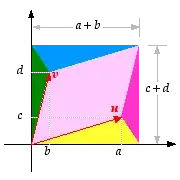Question 1: The volume of a parallelepiped in $\mathbb{R}^n$ with n sides given by the vectors $(x_{1_1}, x_{1_2} ... x_{1_n}), (x_{2_1}, x_{2_2} ... x_{2_n}) ... (x_{n_1}, x_{n_2} ... x_{n_n})$ and diagonal $(x_{1_1} + x_{2_1}+ \cdots + x_{n_1}, x_{1_2} + x_{2_2} + \cdots + x_{n_2}, ..., x_{1_n} + x_{2_n} + \cdots + x_{n_n})$ Is the determinant of the matrix $A = (x_{j, i})$ where i and J are the double sub-scripts on each $x_{i_j}$.
The case where n= 2 has a nice geometric proof. Shown in this diagram:

$u= (a,c)^T$ and $v= (b, d)^T$ then the area of the parallelogram is
$ det \left| [ u | v ] \right| = | ad - bc| $
Is there a "nice" geometric proof for n=3?
The idea behind the n=2 proof is you take the area of the rectangle and subtract the triangles. So, I'm thinking: take the volume of the rectangular solid and subtract tetrahedrons. How many will I need to subtract? Is it possible to draw this?
Question 2: Suppose that (a,b) and (b, a) are points on the unit circle. Find parallelogram with vertices (0,0), (a,b) (a+b, a+b), (b,a) is where $\theta$ is between the x-axis and (a,b).
I know the answer is $|2cos^2 \theta -1|$. I want to get a sense of how difficult this question is. Could an undergrad taking linear for the first time do this? Is it easier if one is asked to prove that the area is $|2cos^2 \theta -1|$ rather than finding it from scratch?
The graphic is from: http://algebra.math.ust.hk/determinant/01_geometry/lecture1.shtml